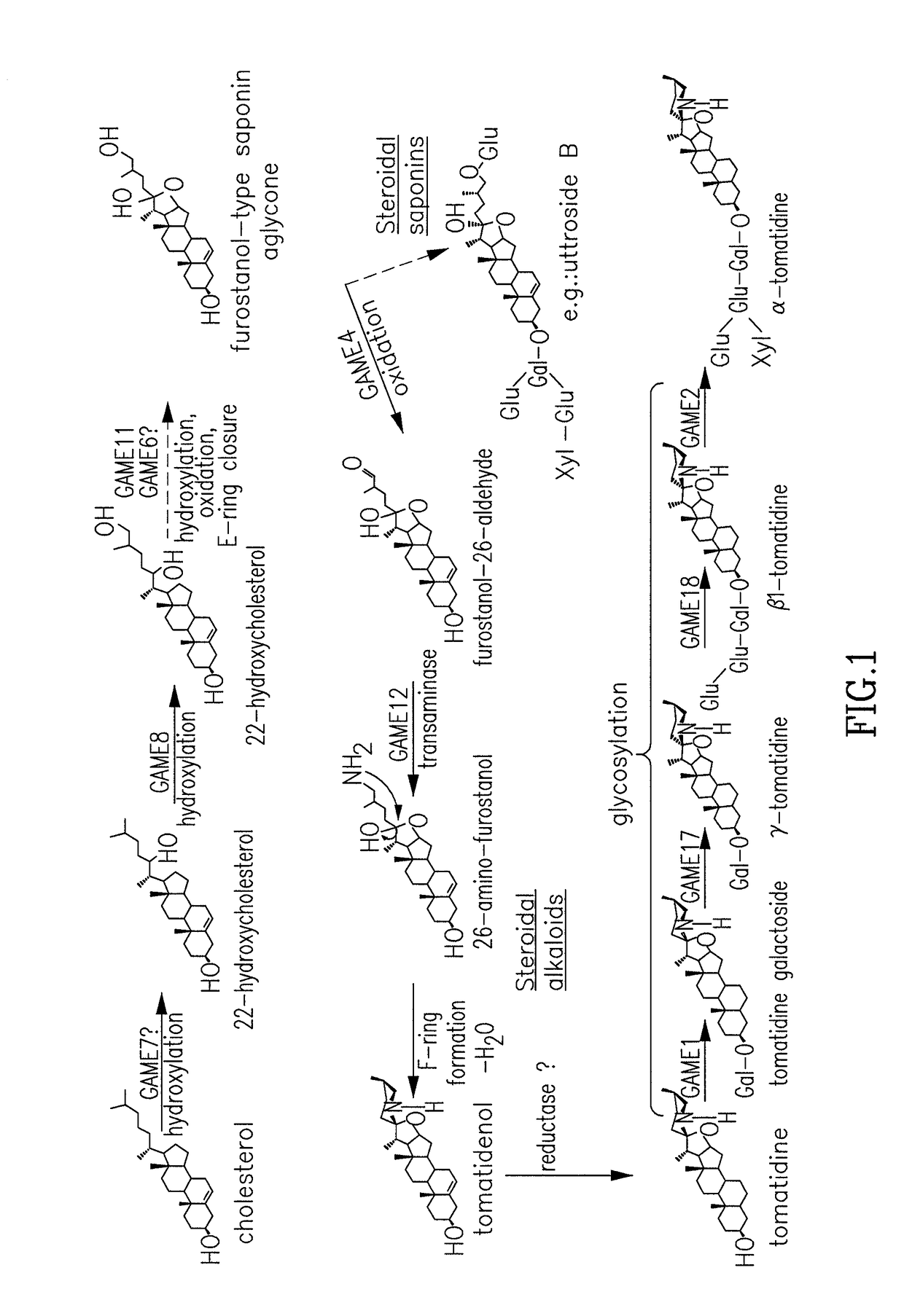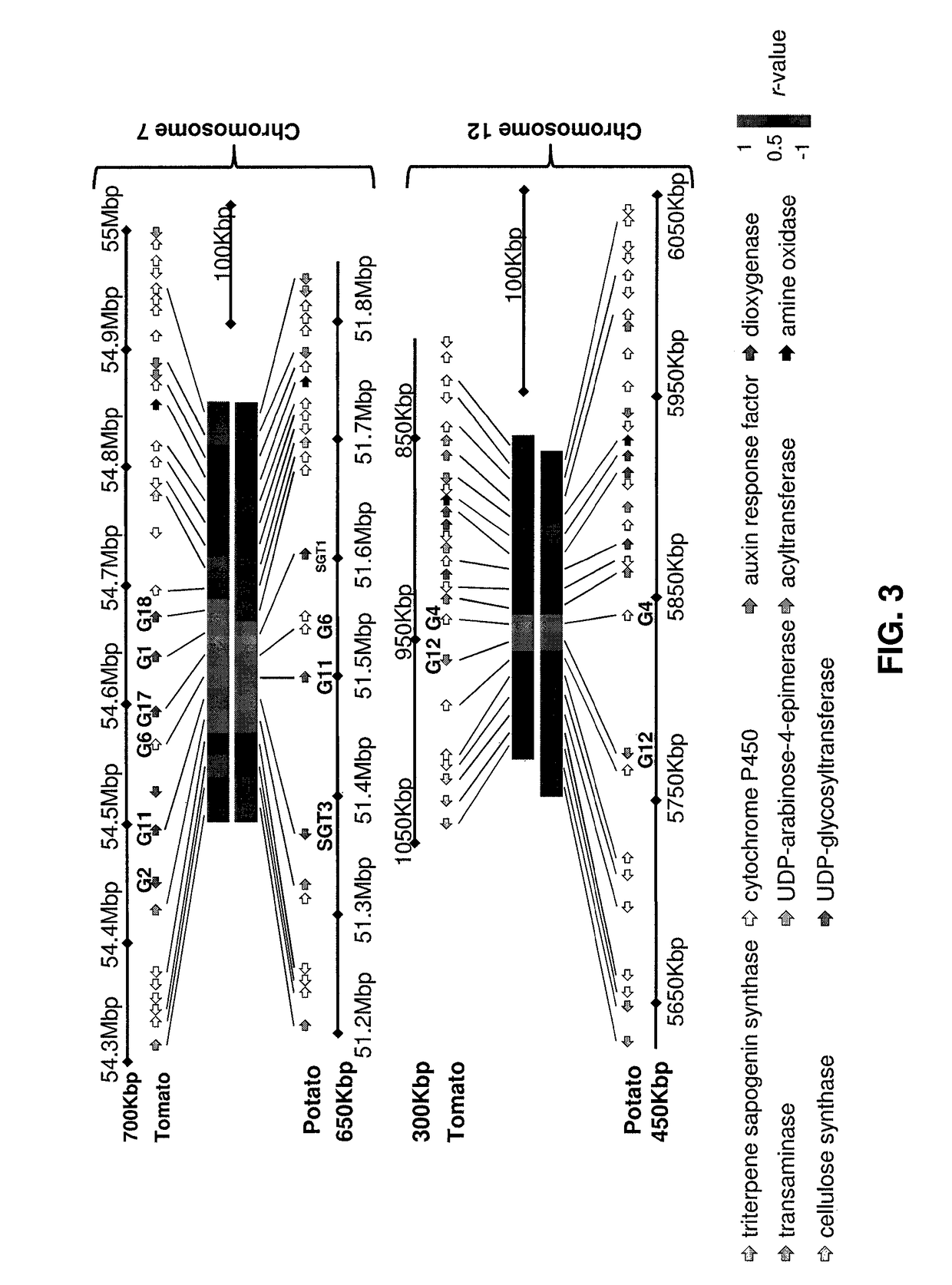Plant with altered content of steroidal glycoalkaloids
a technology of steroid glycoalkaloids and plants, applied in the field of key, can solve the problems of significant elevation/reduction of solanine and/or chacon tomatine in tomato plants, etc., and achieve the effect of improving expression
- Summary
- Abstract
- Description
- Claims
- Application Information
AI Technical Summary
Benefits of technology
Problems solved by technology
Method used
Image
Examples
example 1
ociated with SGA Biosynthesis
[0150]To discover genes associated with SGA biosynthesis, a co-expression analysis using transcriptome data from tomato and potato plants was performed. Coexpression with GAME1 / SGT1 (chromosome 7) and GAME4 (chromosome 12) as “baits” in either potato or tomato are presented in a form of a heatmap in Table 3-6 herein below. Genes that are highly co-expressed with either GAME1 / SGT1 (chromosome 7) or GAME4 (chromosome 12) are depicted with a large font and bold.
[0151]
TABLE 3Accession numbers, putative protein and co-expression r-values-tomato, chromosome 7r-value of correlation with tomato GAME1 Gene namePutative proteinexpressionSolyc07g043310Aminotransferase−0.26Solyc07g043320Unknown Protein0.12Solyc07g043330GRAS family transcription factor0.72Solyc07g043340Unknown ProteinSolyc07g043350Unknown ProteinSolyc07g04336060S ribosomal protein L270.10Solyc07g043370TransposaseSolyc07g043380Unknown ProteinSolyc07g043390Cellulose synthase family0.92proteinSolyc07g04...
example 2
l Analysis of GAME9-Transcription Factor
[0159]GAME9-silencing (RNAi) and overexpressing (OX) constructs were created by introducing the corresponding GAME9 DNA fragments to pK7GWIWG2(II) and pJCV52 binary vectors, respectively. Transgenic tomato and potato lines transformed with the respective GAME9 silencing and overexpressing constructs were generated as previously described (Itkin et al., 2011, supra). Tissue extracts were prepared and analyzed as described in Itkin et al. (2011, supra).
[0160]The metabolic profiling of steroidal alkaloids using UPLC-TQ-MS was performed on extracts obtained from leaves and / or tubers of transgenic and wild type tomato and / or potato plants. In extract obtained from potato tuber peels of potato lines in which the gene encoding GAME9 was silenced (GAME9-RNAi lines) a reduction in α-solanine and α-chaconine was observed (FIGS. 5A and 5B, respectively). Leaves from potato GAME9-overexpression lines contained higher levels of α-solanine (FIG. 5C) and α-c...
example 3
l Characterization of the GAME Genes
GAME11 Silenced Plants
[0162]Virus induced gene silencing (VIGS) is a commonly used technique allowing systemic silencing of genes in various organs of the plant (Dinesh-Kumar S P et al., 2003. Methods Mol Biol 236:287-294).
[0163]Analysis of tomato leaves with VIGS-silenced GAME11, a putative dioxygenase in the cluster, revealed a significant reduction in α-tomatine levels and accumulation of several cholestanol-type steroidal saponins.
[0164]Silencing of GAME11 dioxygenase in tomato results in depletion of α-tomatine levels in leaves (m / z=1034.5) (FIG. 8A) while accumulating cholestanol-type steroidal saponins [i.e. STSs; m / z=1331.6, 1333.6, 1199.6, 1201.6 (major saponins)] (FIG. 8B). FIG. 8C shows MS / MS spectrum of m / z=1331.6 (at 19.28 min) FIG. 8D shows the fragmentation patterns of the saponin eluted at 19.28 min and accumulating in GAME11-silenced leaves. The corresponding mass signals are marked with an asterisk on the MS / MS chromatogram in FI...
PUM
| Property | Measurement | Unit |
|---|---|---|
| volume | aaaaa | aaaaa |
| volume | aaaaa | aaaaa |
| nucleic acid | aaaaa | aaaaa |
Abstract
Description
Claims
Application Information
 Login to View More
Login to View More - R&D
- Intellectual Property
- Life Sciences
- Materials
- Tech Scout
- Unparalleled Data Quality
- Higher Quality Content
- 60% Fewer Hallucinations
Browse by: Latest US Patents, China's latest patents, Technical Efficacy Thesaurus, Application Domain, Technology Topic, Popular Technical Reports.
© 2025 PatSnap. All rights reserved.Legal|Privacy policy|Modern Slavery Act Transparency Statement|Sitemap|About US| Contact US: help@patsnap.com



